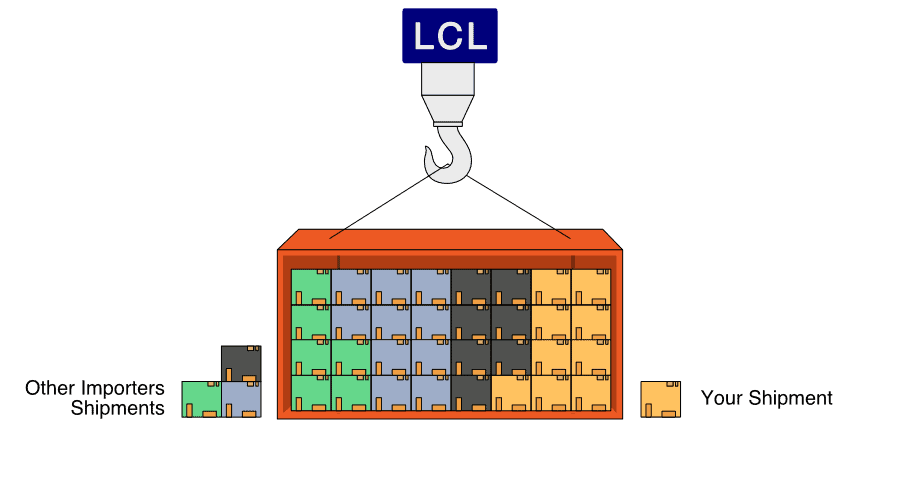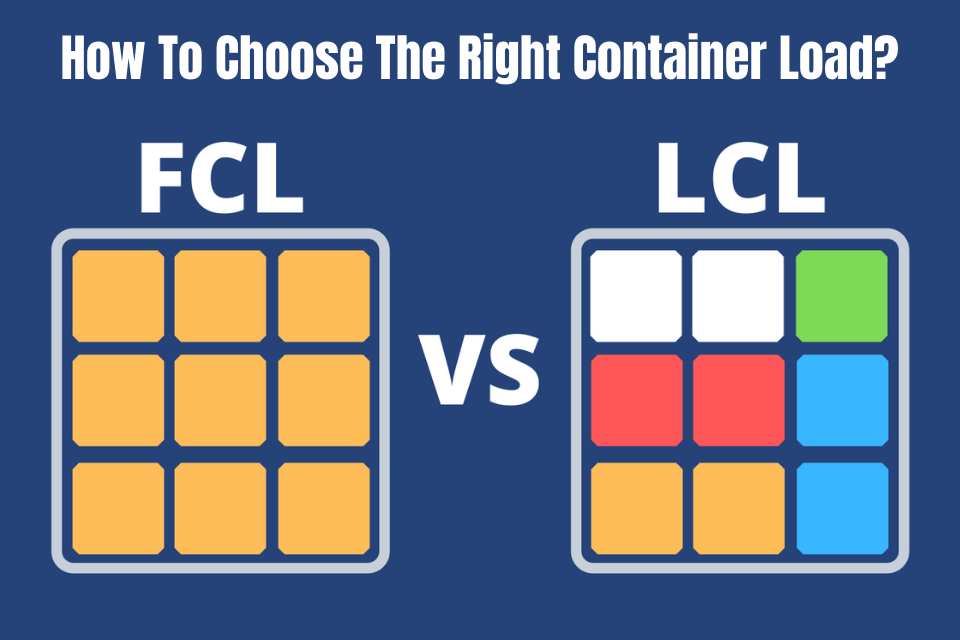- By TOP CHINA FREIGHT
- August 22, 2025
- Shipping
LCL China shipping can feel overwhelming — high costs, complex paperwork, and unclear timelines often make it hard to plan. LCL (Less than Container Load) shipping from China solves this problem by offering an affordable and flexible option for businesses that don’t need a full container. This guide explains everything you need to know — from costs and timelines to tips for avoiding delays — so you can ship smarter and grow your business confidently.

1.What Is LCL Shipping from China?
LCL (Less than Container Load) is an economical and flexible shipping option that allows multiple consignees to share a single container. This method is perfect for businesses that don’t need a full 20ft or 40ft container.
Why LCL Works:
- Your cargo is measured in cubic meters (CBM).
- You only pay for the space you occupy.
- Freight forwarders consolidate cargo heading to the same destination, reducing costs for everyone.
Key Aspect Details Minimum Volume Usually 1 CBM Pricing Unit CBM (Length × Width × Height in meters) Ideal Users Startups, SMEs, e-commerce sellers Common Routes China–USA, China–UK, China–Australia, China–Europe Frequency Weekly sailings from major ports
2.Why Choose LCL Shipping from China
LCL shipping isn’t just cost-effective; it’s a strategic tool for businesses balancing budget, cash flow, and delivery flexibility.
| Advantage | Explanation | Example |
|---|---|---|
| Budget-Friendly | Pay only for the volume you use | Ship 3 CBM for $300 instead of paying $2,000 for a full container |
| Better Cash Flow | Avoid tying up capital in large inventory | Ship smaller batches as you sell |
| Faster Market Entry | Test products without large investments | Launch new products with trial shipments |
| Scalability | Start small and increase shipments over time | Move from LCL to FCL when orders grow |
Case Study:
A small furniture seller in Canada used LCL to ship 6 CBM from Shenzhen. The shipment cost $750, arrived in 34 days, and allowed the company to test demand before scaling to a full container.
3.How to Book LCL Shipping from China

Booking an LCL shipment from China doesn’t need to be complicated. Here’s a step-by-step process:
| Step | Action | Pro Tips |
|---|---|---|
| 1. Measure Cargo | Calculate CBM using length × width × height. | Use a freight calculator to confirm numbers. |
| 2. Request Multiple Quotes | Provide route, cargo details, and HS codes. | Compare costs, transit times, and services. |
| 3. Confirm Booking | Lock in your forwarder and schedule. | Avoid last-minute bookings to prevent delays. |
| 4. Prepare Documentation | Invoice, packing list, licenses, and B/L. | Ensure accuracy to prevent customs delays. |
| 5. Coordinate Pickup | Arrange supplier pickup or deliver cargo to the forwarder’s warehouse. | Ask for photos of packed goods. |
| 6. Track Shipment | Use tracking tools provided by your forwarder. | Monitor every stage, from consolidation to delivery. |
4.Understanding LCL Shipping Costs

LCL costs are multi-layered. Knowing the breakdown helps you manage your budget and avoid hidden fees.
| Cost Component | Description | Typical Range |
|---|---|---|
| Origin Charges | Handling, documentation, and export clearance | $50–$150 |
| Freight Charges | Based on CBM volume | $30–$80 per CBM |
| Destination Charges | Unloading, port handling, and terminal fees | $100–$300 |
| Customs Clearance | Broker fees, duties, and taxes | Varies by HS code |
| Delivery Charges | Optional trucking to your final address | $100–$400 |
Example Calculation:
- Volume: 6 CBM
- Freight rate: $50/CBM → $300
- Origin charges: $120
- Destination charges: $200
- Total sea freight cost: $620
5.How to Reduce LCL Shipping Costs
Combine small batches into one shipment to reach better price tiers.
Plan ahead to ship before September–November rate hikes.
Fewer stops mean fewer fees and shorter transit.
Regular shippers can request loyalty discounts from forwarders.
6.LCL vs. FCL: Which One Should You Choose?

| Aspect | LCL | FCL |
|---|---|---|
| Volume | 1–15 CBM | 15+ CBM |
| Cost | Pay per CBM | Flat fee for entire container |
| Transit Time | Longer due to consolidation | Faster |
| Handling Risk | Slightly higher | Lower |
| Flexibility | High – ship anytime | Lower – wait to fill container |
Rule of Thumb:
- Ship less than 12–15 CBM → Use LCL.
- Ship more than 15 CBM → Upgrade to FCL to save on total cost.
7.Common Problems in LCL Shipping and How to Solve Them
| Problem | Cause | Solution |
|---|---|---|
| Consolidation Delays | Not enough cargo to fill a container | Book early with a forwarder that runs weekly consolidations |
| Cargo Damage | Multiple handling stages | Invest in professional packaging and proper labeling |
| Hidden Charges | Non-transparent pricing | Always request a full cost breakdown |
| Customs Delays | Incomplete or inaccurate documents | Double-check HS codes and paperwork |
| Storage Fees | Late pickup at destination port | Coordinate clearance and trucking in advance |
8.Choosing the Right LCL Freight Forwarder

A good freight forwarder is critical to smooth LCL shipping.
| Selection Criteria | What to Look For |
|---|---|
| Experience | At least 5–10 years in LCL shipping |
| Network | Strong carrier relationships and global partners |
| Service Options | Door-to-door, warehousing, customs brokerage |
| Transparency | Clear pricing with no hidden fees |
| Customer Support | Responsive communication and proactive updates |
Pro Tip:
Ask for customer testimonials or case studies to verify reliability.
9.Documentation Checklist for LCL Shipments
| Document | Purpose |
|---|---|
| Bill of Lading (B/L) | Proof of shipment and ownership |
| Commercial Invoice | Declares value for customs duties |
| Packing List | Lists quantities, dimensions, and weights |
| Certificate of Origin | Required for tariff preferences |
| Import Licenses | Needed for restricted goods |
Documentation Tips:
- Always match descriptions across all documents.
- Submit paperwork early to avoid clearance delays.
- Use HS codes correctly to prevent misclassification penalties.
10.How to Avoid LCL Shipping Delays
Book at least two weeks in advance.
Shanghai, Shenzhen, and Ningbo offer more reliable schedules.
Ship in Q1 or Q2 to avoid congestion.
Track shipments and communicate with your forwarder regularly.
Small errors can lead to big delays at customs.
11.Risk Management for LCL Cargo
LCL shipping involves multiple handling stages, which can increase risks.
| Risk | Mitigation |
|---|---|
| Damage | Use sturdy packaging, moisture protection, and proper labeling |
| Loss | Buy cargo insurance that covers partial shipments |
| Customs Issues | Hire a licensed customs broker |
| Delays | Partner with forwarders that provide real-time tracking |
12.Tech Tools for Better LCL Shipping
1Online Freight Calculators:
Estimate CBM and costs quickly.
2.Digital Platforms:
Track shipments in real time.
3.AI Forecasting Tools:
Predict transit delays during peak seasons.
4.Customs Management Software:
Automate documentation and reduce human error.
Conclusion
LCL China shipping is one of the smartest solutions for businesses that need to move smaller volumes without breaking the bank. By understanding how LCL works — from cost breakdowns and documentation to selecting the right freight forwarder — you can minimize delays, avoid hidden fees, and keep your supply chain running smoothly. Whether you’re a startup testing the market or an established business optimizing cash flow, LCL shipping provides the flexibility and affordability you need.
Need a Shipping Quote?
If you want expert guidance and peace of mind, our team is ready to assist.
TJ China Freight offers tailored solutions to help businesses of all sizes ship more reliably from China.
FAQs
Q1:How much does LCL China shipping cost per CBM?
LCL shipping typically costs $30–$80 per CBM, depending on your route, season, and service level. Additional charges for origin handling, destination fees, and customs clearance may apply.
Q2:What documents are needed for LCL shipments?
You’ll usually need:
- Bill of Lading (B/L)
- Commercial Invoice
- Packing List
- Certificate of Origin (if applicable)
- Import licenses (for restricted goods)
Q3:Is LCL shipping safe for fragile items?
Yes, but you need proper packaging and labeling. Use double-layer boxes, bubble wrap, and “Fragile” labels. Inform your forwarder so they can handle your cargo with care during consolidation.
Q4:How do I avoid hidden fees in LCL shipping?
- Request a full cost breakdown from your forwarder.
- Understand destination charges upfront.
- Ask about documentation fees and handling fees to avoid surprises.
Q5:When should I switch from LCL to FCL?
If your shipment volume is 15 CBM or more, it’s usually cheaper and faster to book a Full Container Load (FCL). Always compare total costs, not just per-CBM rates.
